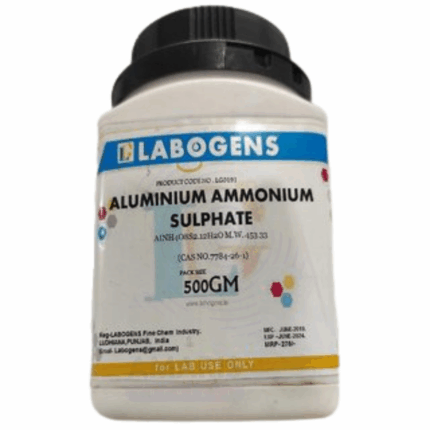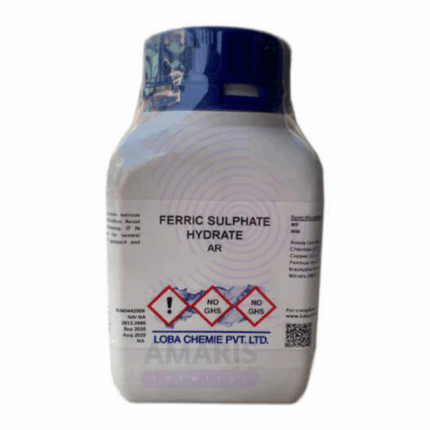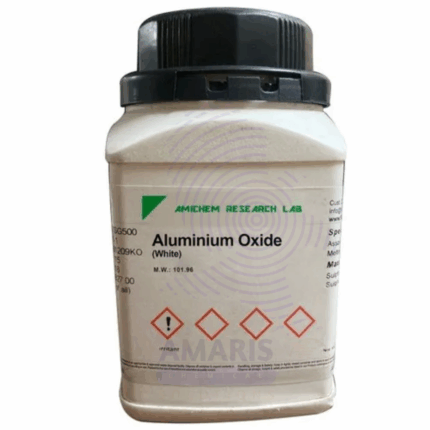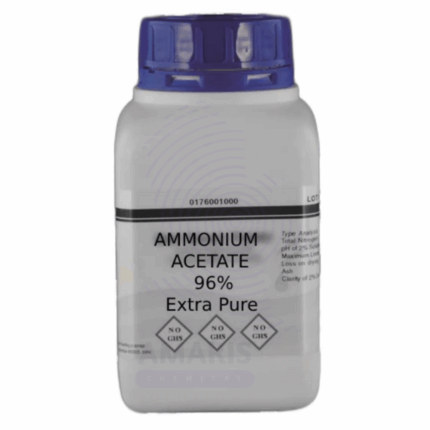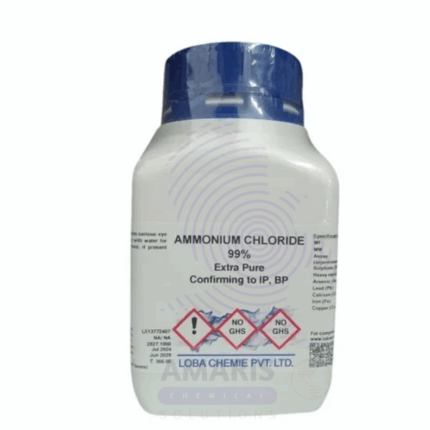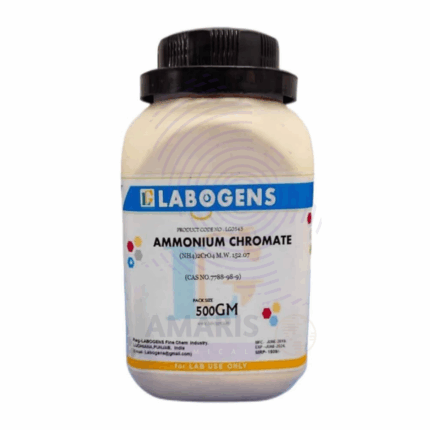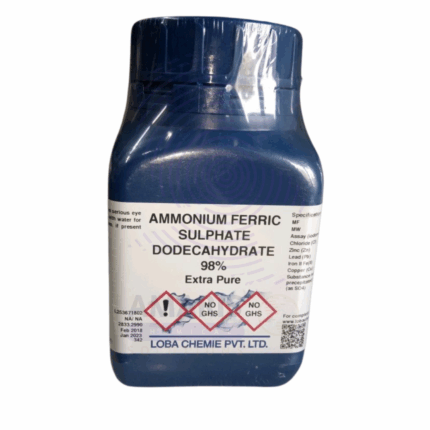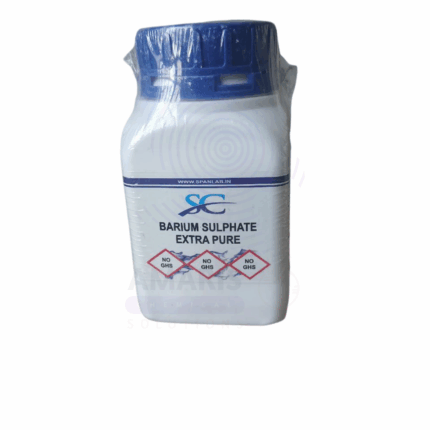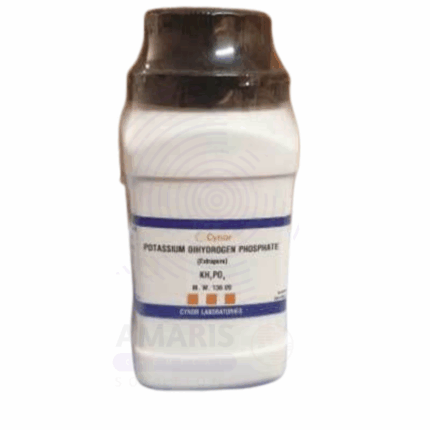
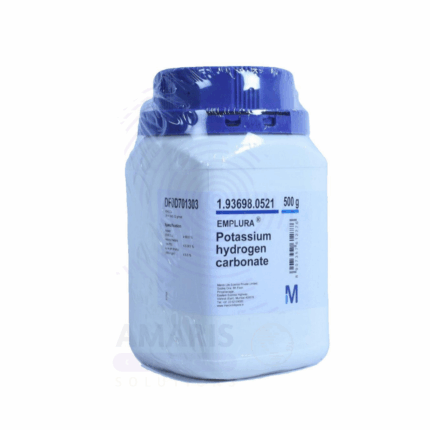
Potassium Ferrocyanide Extra Pure
$ 16.79 Original price was: $ 16.79.$ 16.67Current price is: $ 16.67.
Potassium Ferrocyanide Extra Pure is a pale yellow crystalline salt known for its stability and low toxicity in pure form. It is widely used in analytical chemistry for the detection of metal ions, particularly in the formation of Prussian blue with iron. In industrial settings, it serves roles in pigment production, electroplating, and as an anti-caking agent in salt. Despite the presence of “cyanide” in its name, it is non-toxic under normal conditions due to its tightly bound cyanide groups. This compound should be handled with care and stored in sealed containers in a cool, dry area, away from acids and oxidizing agents.
Potassium Ferrocyanide Extra Pure
PRIMARY USES
- Analytical Reagent:
- Widely used in qualitative and quantitative chemical analysis to detect metal ions such as iron(III) (forms Prussian Blue).
- Utilized in complexometric titrations.
- Pigment Production:
- Key precursor in the production of Prussian Blue pigment, used in paints, inks, and dyes.
- Food Industry (under strict regulation):
- Serves as an anti-caking agent (E536) in table salt to prevent clumping.
- Photographic Industry:
- Acts as a component in photographic processing chemicals and blueprint paper production (cyanotype process).
SECONDARY USES
- Textile Industry:
- Used in dyeing and printing fabrics with blue and black pigments.
- Electroplating:
- Functions as an additive in certain electroplating baths, especially for zinc and iron.
- Heat Treatment:
- Occasionally applied in case hardening of steel to improve surface durability.
1. Basic Identification Attributes
- Chemical Name: Potassium Ferrocyanide
- CAS Number: 14459-95-1 (common trihydrate form) / 13943-58-3 (anhydrous)
- HS Code: 2837.20.00
- Molecular Formula: K₄[Fe(CN)₆]·3H₂O (trihydrate)
- Synonyms:
- Yellow prussiate of potash
- Potassium hexacyanoferrate(II)
- Tripotassium ferrocyanide
- Potassium ferrocyanide trihydrate
2. Physical & Chemical Properties
- Physical State: Solid (crystalline powder or granules)
- Color & Odor: Lemon-yellow, odorless
- Boiling Point & Melting Point:
- Melting Point: ~60 °C (loses water of hydration)
- Decomposes at higher temperatures before boiling
- Density/Specific Gravity: ~1.85 g/cm³
- Solubility:
- Soluble in water (~33 g/100 mL at 20 °C)
- Insoluble in alcohol and ether
- pH Level: ~6 to 8 (1% solution in water)
- Vapor Pressure & Volatility: Non-volatile
- Flash Point: Not flammable
- Autoignition Temperature: Not applicable
- Viscosity: Not applicable (solid)
3. Safety & Hazard Attributes
- Hazard Class (GHS Classification):
- Not classified as hazardous under GHS for normal laboratory use
- Cyanide component may release toxic gases if acidified
- NFPA Ratings:
- Health: 1
- Flammability: 0
- Reactivity: 2
- Exposure Limits:
- No OSHA PEL or ACGIH TLV specifically assigned
- Reactivity:
- Stable under normal conditions
- Releases toxic hydrogen cyanide (HCN) gas when mixed with acids
4. Storage & Handling Attributes
- Storage Conditions:
- Store in tightly sealed containers in a cool, dry, well-ventilated area
- Protect from acids and moisture
- Incompatible Materials:
- Acids, strong oxidizing agents
- Container Type:
- Glass or plastic containers with secure lids
- Shelf Life & Expiration Date:
- Stable for several years if properly stored
- Special Handling Requirements:
- Avoid inhaling dust or fumes
- Use gloves, eye protection, and handle in well-ventilated area
5. Regulatory & Compliance Attributes
- Regulatory Status:
- Listed in TSCA, REACH compliant
- Food additive use (as anti-caking agent E536) in small controlled quantities
- Hazard Symbols (GHS Pictograms):
- None required unless acidification risk is present
- Transportation Restrictions:
- Not regulated for general transport unless part of a hazardous mixture
- Waste Disposal Method:
- Dispose of according to local and national environmental regulations
- Avoid releasing to the environment in large amounts
6. Environmental & Health Impact
- Ecotoxicity:
- Low toxicity in neutral/basic solutions
- Toxic to aquatic life if acidified (cyanide release risk)
- Persistence in Environment:
- Stable in neutral/alkaline environments
- Degrades in sunlight and acidic conditions
- Carcinogenicity/Mutagenicity:
- Not classified as carcinogenic or mutagenic
- Biodegradability:
- Inorganic complex; not biodegradable but relatively stable under proper conditions
- Inorganic complex; not biodegradable but relatively stable under proper conditions
SAFETY PRECAUTIONS
Personal Protective Equipment (PPE):
- Wear chemical-resistant gloves (e.g., nitrile or neoprene).
- Use safety goggles or a face shield.
- Wear a lab coat and closed footwear.
- Use only with adequate local exhaust ventilation.
Handling:
- Avoid formation of dust and inhalation of particles.
- Do not ingest. Avoid contact with eyes and skin.
- Wash hands thoroughly after handling.
Storage:
- Store in a tightly sealed container in a dry, cool, and well-ventilated area.
- Keep away from strong acids—can release toxic hydrogen cyanide gas.
- Protect from moisture and incompatible substances.
FIRST AID MEASURES
Inhalation:
- Move to fresh air immediately.
- Keep the affected person warm and at rest.
- Seek medical attention if symptoms persist.
Skin Contact:
- Wash thoroughly with soap and plenty of water.
- Remove contaminated clothing.
- Get medical attention if irritation or allergic reaction occurs.
Eye Contact:
- Rinse immediately with plenty of water for at least 15 minutes.
- Keep eyelids open and away from the eyeball during rinsing.
- Seek medical advice if irritation develops.
Ingestion:
- Rinse mouth. Do not induce vomiting.
- Give water if the person is conscious.
- Seek immediate medical attention.
FIRE FIGHTING MEASURES
Flammability:
- Non-combustible but can decompose at high temperatures.
Extinguishing Media:
- Use water spray, dry powder, carbon dioxide (CO₂), or appropriate foam for surrounding fire.
Hazardous Combustion Products:
- May emit toxic fumes such as nitrogen oxides, carbon monoxide, and hydrogen cyanide when heated.
Firefighter Protection:
- Wear full protective gear and self-contained breathing apparatus (SCBA).
- Avoid inhalation of gases released during thermal decomposition.


 Preservatives(food)
Preservatives(food) Flavor Enhancers
Flavor Enhancers Acidulants
Acidulants Sweeteners
Sweeteners Antioxidants
Antioxidants Colorants(food)
Colorants(food) Nutraceutical Ingredients (food)
Nutraceutical Ingredients (food) Nutrient Supplements
Nutrient Supplements Emulsifiers
Emulsifiers
 Collectors
Collectors Dust Suppressants
Dust Suppressants Explosives and Blasting Agents
Explosives and Blasting Agents Flocculants and Coagulants
Flocculants and Coagulants Frothers
Frothers Leaching Agents
Leaching Agents pH Modifiers
pH Modifiers Precious Metal Extraction Agents
Precious Metal Extraction Agents
 Antioxidants(plastic)
Antioxidants(plastic) Colorants (Pigments, Dyes)
Colorants (Pigments, Dyes) Fillers and Reinforcements
Fillers and Reinforcements Flame Retardants
Flame Retardants Monomers
Monomers Plasticizers
Plasticizers Polymerization Initiators
Polymerization Initiators Stabilizers (UV, Heat)
Stabilizers (UV, Heat)
 Antifoaming Agents
Antifoaming Agents Chelating Agents
Chelating Agents Coagulants and Flocculants
Coagulants and Flocculants Corrosion Inhibitors
Corrosion Inhibitors Disinfectants and Biocides
Disinfectants and Biocides Oxidizing Agents
Oxidizing Agents pH Adjusters
pH Adjusters Scale Inhibitors( water)
Scale Inhibitors( water)
 Antioxidants(cosmetic)
Antioxidants(cosmetic) Emollients
Emollients Fragrances and Essential Oils
Fragrances and Essential Oils Humectants
Humectants Preservatives
Preservatives Surfactants(cosmetic)
Surfactants(cosmetic) Thickeners
Thickeners UV Filters
UV Filters
 Fertilizers
Fertilizers Soil Conditioners
Soil Conditioners Plant Growth Regulators
Plant Growth Regulators Animal Feed Additives
Animal Feed Additives Biostimulants
Biostimulants Pesticides (Herbicides, Insecticides, Fungicides)
Pesticides (Herbicides, Insecticides, Fungicides)
 Active Pharmaceutical Ingredients (APIs)
Active Pharmaceutical Ingredients (APIs) Excipients
Excipients Solvents(pharmaceutical)
Solvents(pharmaceutical) Antibiotics
Antibiotics Antiseptics and Disinfectants
Antiseptics and Disinfectants Vaccine Adjuvants
Vaccine Adjuvants Nutraceutical Ingredients (pharmaceutical)
Nutraceutical Ingredients (pharmaceutical) Analgesics & Antipyretics
Analgesics & Antipyretics
 Analytical Reagents
Analytical Reagents Solvents(lab)
Solvents(lab) Chromatography Chemicals
Chromatography Chemicals Spectroscopy Reagents
Spectroscopy Reagents microbiology-and-cell-culture-reagents
microbiology-and-cell-culture-reagents Molecular Biology Reagents
Molecular Biology Reagents Biochemical Reagents
Biochemical Reagents Inorganic and Organic Standards
Inorganic and Organic Standards Laboratory Safety Chemicals
Laboratory Safety Chemicals Specialty Laboratory Chemicals(Special Laboratory Equipment)
Specialty Laboratory Chemicals(Special Laboratory Equipment)
 Demulsifiers
Demulsifiers Hydraulic Fracturing Fluids
Hydraulic Fracturing Fluids Scale Inhibitors(oil)
Scale Inhibitors(oil) Surfactants(oil)
Surfactants(oil) Drilling Fluids
Drilling Fluids
 Dyes and Pigments
Dyes and Pigments Bleaching Agents
Bleaching Agents Softening Agents
Softening Agents Finishing Agents
Finishing Agents Antistatic Agents
Antistatic Agents
 Admixtures
Admixtures Waterproofing Agents
Waterproofing Agents Sealants and Adhesives
Sealants and Adhesives Curing Compounds
Curing Compounds Concrete Repair Chemicals
Concrete Repair Chemicals Anti-Corrosion Coatings
Anti-Corrosion Coatings
 Surfactants(cleaning)
Surfactants(cleaning) Builders
Builders Enzymes
Enzymes Solvents (Cleaning)
Solvents (Cleaning) Fragrances
Fragrances
 Electronic Chemicals
Electronic Chemicals Catalysts
Catalysts Lubricants
Lubricants Photographic Chemicals
Photographic Chemicals Refrigerants
Refrigerants Automotive chemicals
Automotive chemicals Pyrotechnic Chemicals
Pyrotechnic Chemicals
 Biodegradable Surfactants
Biodegradable Surfactants Bio-based Solvents
Bio-based Solvents Renewable Polymers
Renewable Polymers Carbon Capture Chemicals
Carbon Capture Chemicals Wastewater Treatment Chemicals
Wastewater Treatment Chemicals
 Pigments
Pigments Solvents(paint)
Solvents(paint) Specialty Coatings
Specialty Coatings Binders/Resins
Binders/Resins Additives
Additives Driers
Driers Anti-Corrosion Agents
Anti-Corrosion Agents Functional Coatings
Functional Coatings Application-Specific Coatings
Application-Specific Coatings
 Fresh Herbs
Fresh Herbs Ground Spices
Ground Spices Whole Spices
Whole Spices Spice Blends
Spice Blends Dried Herbs
Dried Herbs
 Leavening Agents
Leavening Agents Dough Conditioners
Dough Conditioners Flour Treatments
Flour Treatments Fat Replacers
Fat Replacers Decoratives
Decoratives Preservatives(baking)
Preservatives(baking)
 Plasticizers & Softeners
Plasticizers & Softeners Reinforcing Agents
Reinforcing Agents Adhesion Promoters
Adhesion Promoters Vulcanizing Agents
Vulcanizing Agents Antidegradants
Antidegradants Blowing Agents
Blowing Agents Fillers & Extenders
Fillers & Extenders Accelerators & Retarders
Accelerators & Retarders

